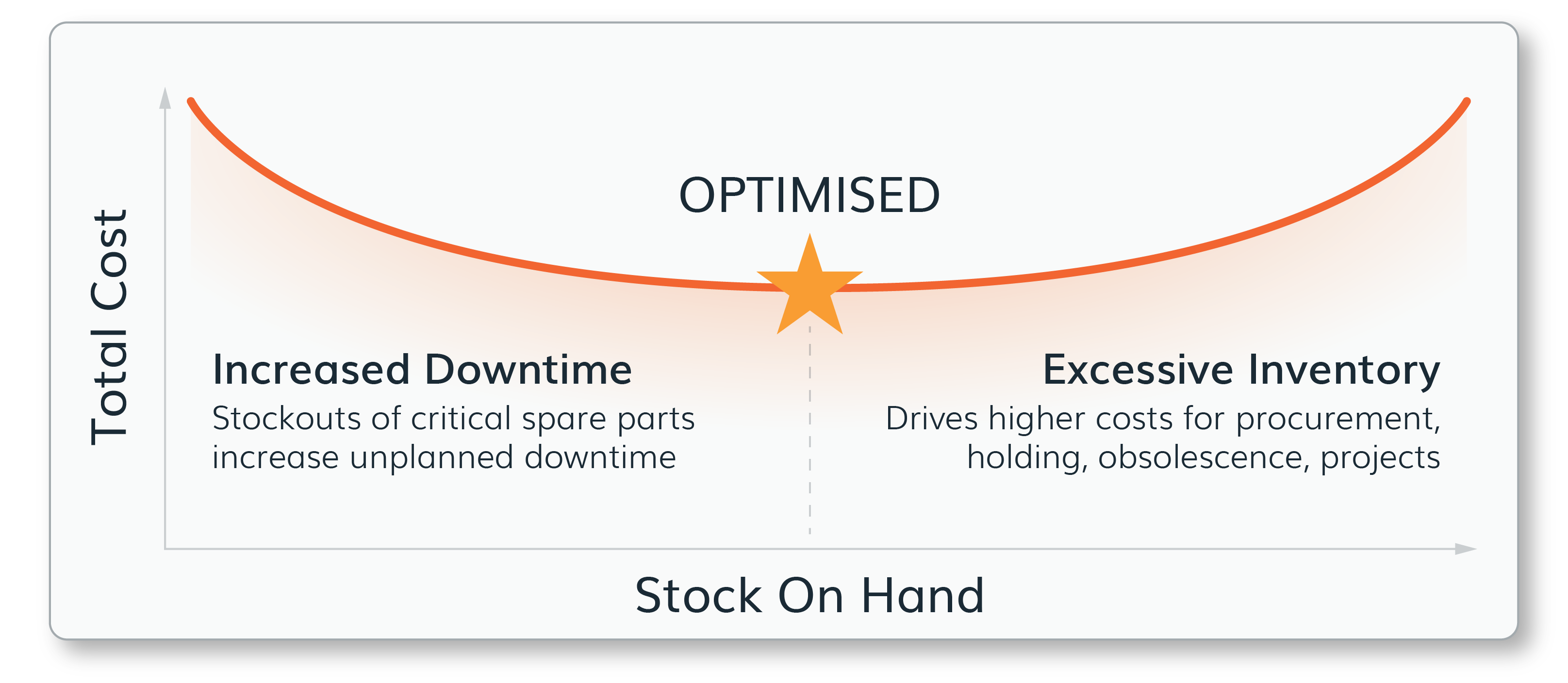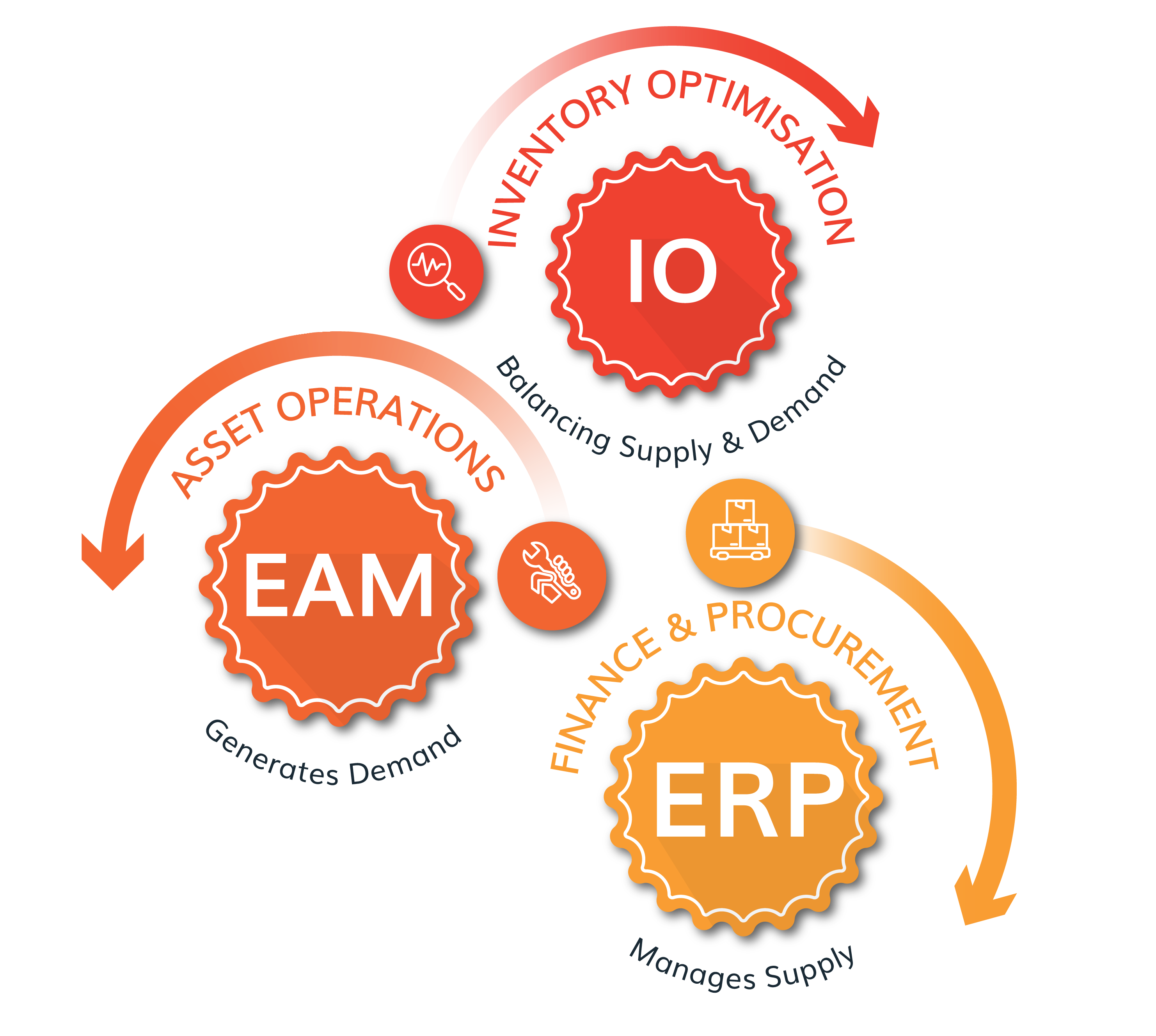At a glance
- Optimising MRO Inventory is often overlooked, but inefficient practices mean working capital is locked up in materials, and downtime due to stockouts is unnecessarily high.
- Finding the right amount of inventory to hold is complex due to the high number of variables to consider for hundreds and thousands of parts.
- Smart technology solutions, like IBM MRO Inventory Optimization, employ advanced statistical analytics to provide data-based stocking-level recommendations.
- Optimising MRO Inventory has the potential to deliver up to 40% reduction in inventory costs and 50% reduction in unplanned downtime.
MRO inventory optimisation is crucial for results-oriented asset operations, yet the keys to success are not well understood.
When the supply of the tools, spare parts and consumables needed to operate and maintain assets is optimised, organisations enjoy substantial cost savings and operational efficiencies. All too often, however, COSOL’s asset management experts spot the symptoms of limited focus on effective MRO inventory management - shadow inventories held in departmental silos, critical spares purchased on credit cards through retail channels to deliver emergency repairs - all generating unnecessary duplication and waste.
When as much as 50% of unscheduled downtime can be attributed to a lack of spare parts or stockouts^, improving MRO inventory practices is not an opportunity that asset-intensive organisations should ignore - particularly when that downtime impacts the ability to deliver clean water, electricity or resources to its' customers. With the right tools and technology, supported by the right MRO processes and best practices, successful companies are making MRO inventory optimisation a reality and reaping substantial rewards.
Taking inventory management to the next level
Effective inventory management should be a priority for every asset-intensive organisation. It provides operational control and accurate data around the process of ordering, storing and moving the items and equipment needed to operate and maintain the organisations’ assets and facilities. Optimisation takes this to the next level by capturing, analysing and applying data-driven insights to inventory management processes.

Above: The costs of under or over stocking
- Holding too little will inevitably lead to increased downtime as stockouts of critical spares prevent routine maintenance and emergency repairs from being completed.
- Hold too much and procurement, storage and handling costs increase, along with the risk of parts becoming obsolete.
MRO inventory defined
MRO inventory refers to supplies, spare parts and other materials needed for routine Maintenance, Repair and Operations (or MRO). It includes the materials and equipment you need to keep mission-critical assets continuously running smoothly, such as:
- Tools (spanners, ratchets, clamps, fasteners, grinders, etc.)
- Lubricants and oils
- Safety equipment and PPE
- Industrial equipment (pumps, compressors, etc.)
- Spare parts
The optimisation challenge
Although the concept of inventory optimisation sounds like simple good business sense, finding that magic “right amount” isn’t always simple. A high number of variables to consider - criticality, lead time, work-around options, minimum and maximum stock counts, and stockout costs to name a few - multiplied by the massive number of unique parts plus the need to address cross-functional requirements makes the science of optimisation particularly complex.
Companies can rely on up to a million unique MRO items, leaving only two minutes per year to manage each part. Common approaches to managing and improving MRO inventory typically involve throwing people and money at the problem, but that can only go so far:
ERP/EAM Systems
While Enterprise Resource Planning (ERP) and Enterprise Asset Management (EAM) solutions like SAP and IBM Maximo contribute enormously to managing MRO inventory. These systems can lack the analytical capabilities to forecast requirements for inventory optimisation, particularly for MRO items as opposed to raw materials or finished products. ERP, for example, controls reordering processes based on current stock holdings and the recorded minimum and maximum values set for each item, but it can’t calculate what the optimal minimum and maximum levels should be to most efficiently support operations.
Demand for MRO inventory can be unpredictable….unplanned maintenance is, by definition, unplanned after all. ERP/EAM systems can’t analyse historical transactions to forecast likely requirements to support unplanned works or accommodate management by exception for high-cost or low-turnover items. Identifying the criticality of specific items can also be a complex calculation based on multiple criteria that draw on relevant data outside ERP/EAM environment.
Spreadsheets
Spreadsheets attempt to apply some science to inventory analysis and optimisation, but are limited in their effectiveness. Business intelligence functions are built manually and any errors trickle down over time, ultimately resulting in continued over or under-ordering. Apart from basic collaborative authoring, spreadsheets are neither easily shared nor auditable. Without real-time integration with ERP/EAM systems, spreadsheets are only ever as good as the manually entered data and insights cannot be directly actioned.
Internal expert
Drawing on corporate memory and assumed knowledge, internal experts offer a non-scientific - or ‘gut-feel’ approach to optimising inventory. This approach is often accompanied by duplicate inventory, or private hoards, of items stashed aside by separate maintenance teams based on past experiences. With no company-wide methodology or standards to justify decisions, arbitrary methodologies are rife - ordering 10 of everything just to be safe, or doubling previous order quantities after a high-impact stockout experience for example. It’s an approach that doesn’t scale well and carries increased risk in an ageing workforce when internal experts retire from the organisation.
Homegrown systems
Some organisations develop customised applications in an attempt to build the required analytical capabilities into, or alongside, ERP and EAM systems. However, in-house development simply can’t match the years of experience, research and development invested in purpose-built commercial optimisation solutions. Depending on the development platform and methodology employed, technical risk to the organisation can be significantly increased. Extensive customisation and complex integration can result in the entire ERP/EAM environment becoming more costly to support and potentially preventing core product upgrades from being applied, forcing the company to miss out on advancing functionality.
The cost of not optimising MRO inventory to operations and revenue
Without standardised, data-driven processes to optimise the demand for spare parts as operations evolve, companies experience excess inventory, added headcount of staff engaged in manual inventory analysis, cost inefficiencies and stockout of critical spare parts - leading to costly downtime and diminished asset effectiveness. The end result is diminishing profits as MRO inventory on the balance sheet spirals at a rate of 2-10% per year.*
- Bloated inventory
- Equipment downtime
- Parts become obsolete on the shelf
- Bloated headcount
- Endless spending on inventory reduction projects
Transformative business benefits
By leveraging technology tools, automated processes and inventory management best practices to optimise MRO spares and consumables, asset-intensive organisations can consistently produce results* like these:

Above: Results achieved from inventory optimisation*
When the value of MRO inventory holdings exceeds $50 million, optimisation has the potential to significantly increase the working capital available to the business and return on investment is typically achieved in less than a year.
The engine of optimisation
Benefits on this scale can’t be realised without engaging the right tools for the job and adopting new, data-driven approaches to inventory analysis, forecasting and decision-making.
“ERP and EAM systems that are built around material resource planning or other manufacturing processes are not sufficient to handle these MRO problems … companies that can provide an asset performance management solution with advanced analytics to optimise MRO spares and materials are expected to secure a leadership position in the market.”
Sankara Narayanan - Senior Analyst, Frost & Sullivan
Smart technology solutions like IBM’s MRO Inventory Optimization (MRO IO) can help companies continuously optimise their MRO parts inventory. Not just one time, but continuously. It does this by providing stocking-level recommendations, based on prescriptive analytics and optimisation algorithms built into the solution that are tuned specifically for spare parts. By applying a rules-based engine to analyse all the variables - including criticality, lead time, price and usage - MRO IO adopts a scientific approach to automatically identify the elusive “right amount” of inventory in a manner that is easy to understand and action.
Dynamic, innovative asset management organisations will not rely on one single solution to manage their operations, but rather an asset information ecosystem in which a selection of tools and technologies are employed to best support business processes across different asset classes and lifecycle stages. As a result, the data required to effectively optimise MRO inventory resides in lots of different places and integration is key. MRO IO provides certified integration connectors to routinely integrate and extract data into the solution and then perform extensive analysis. The solution can interoperate with one or many host data systems and seamlessly integrates with EAM and ERP systems, including:
- IBM Maximo Application Suite
- SAP
- Oracle
- Hitachi Ellipse

Above: Mature asset management employs the best-fit tools for each purpose, operating together within an integrated asset information ecosystem.
Keys to success
Implementing technology alone, however, is rarely a recipe for success.
COSOL’s experts recommend starting with Criticality Analysis. Too often material optimisation efforts are attempted in silos, resulting in the materials associated with critical assets no longer being held in inventory, or having lead times that will cause a business risk. To understand which parts are critical to operations or employee safety, and which are “nice to have” but not urgent, generate a criticality score that reflects the business impact for each stock item. Consider factors like where it is used, practical workarounds, supplier lead times and pricing. A full review and validation of critical spares and safety equipment should be conducted on an annual basis and close collaboration with maintenance sustained to ensure no critical items are inadvertently removed when actioning optimisation recommendations.
Quality preventive maintenance master data - such as equipment, task lists and bill of materials can also impact inventory holdings. With confidence in the accuracy and integrity of maintenance master data, organisations can reduce their reliance on holding stock for just-in-case or breakdown maintenance. Attention should also be given to data quality in material masters, particularly item pricing and supply lead times. Recent experiences, from global pandemics to natural disasters, demonstrate that supply chain disruption can impact everyone from suppliers to end users and that consistent performance cannot be assumed.
Like COVID-19, there are any number of factors beyond maintenance plans or supplier recommendations that can impact stock usage. For example, material usage can change significantly during wet weather events after an extended dry period, making accurate predictions and optimisation a process that requires the support of robust scientific analysis.
Based on analysis of client experiences with MRO inventory optimisation, IBM have developed best practices to unlocking working capital through inventory optimisation. They include:
-
Reordering Parameters - the reordering parameters (minimum and maximum levels) used by the ERP and EAM materials management systems to generate replenishment orders are the main determinants of inventory outcomes. Reordering parameters should be optimised periodically to reflect changes in usage, lead time, criticality and other factors.
-
Inventory Segmentation - inventory segmentation provides a management framework for inventory that recognises that a number of different management techniques are required for various item profiles.
-
Spares Pooling - significant reductions in overall safety stock investment are possible through the pooling or sharing of high-value, infrequent items (insurance spares) across multiple sites. To facilitate such arrangements, asset-intensive companies need to identify parts that are suitable for sharing and determine optimal holding numbers and locations.
-
Reporting inventory KPIs - inventory KPI reporting is important to allow progress in improving inventory to be tracked. KPI reporting should include a selection of pre-defined inventory management reports along with the ability for users to customise reports and statistics.
Many leaders in asset-intensive industries throughout the world complement and extend the value of ERP/EAM systems such as IBM Maximo, SAP, Oracle, Hitachi Ellipse and others with these best practices and IBM’s MRO IO capabilities. By optimising their MRO inventories, organisations can increase their production and uptime, bolster their agility and increase their cashflow as contributors to successful business performance and sustained competitive advantage.
Uncover a clearer, more accurate view of your inventory
^ Aberdeen Group, IBM MRO IO Client Presentation
*Based on IBM internal analysis of client data. Individual client results will vary.


